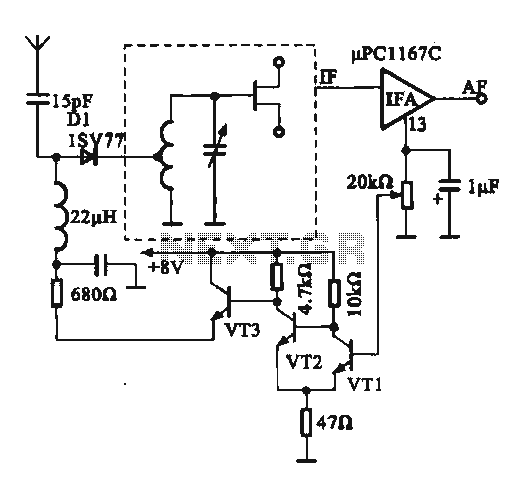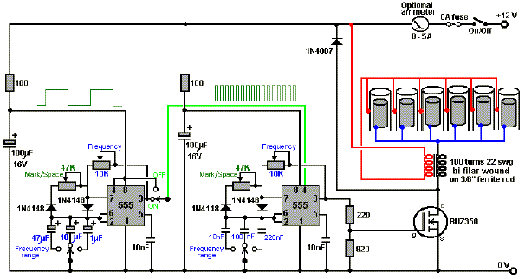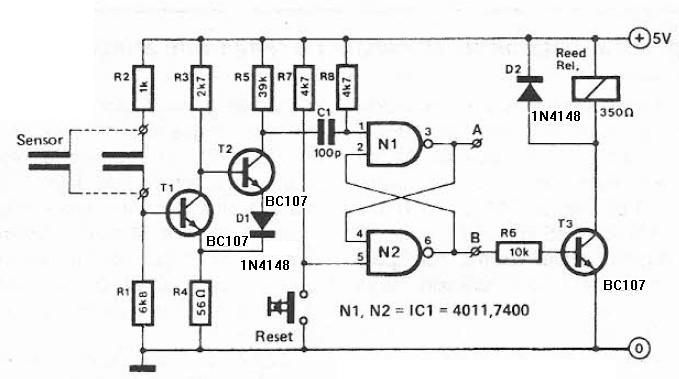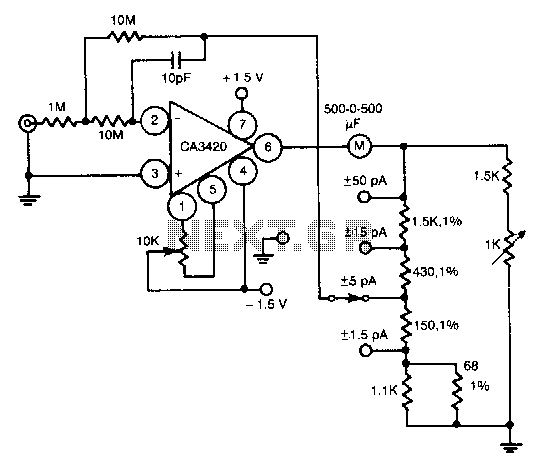
1W FM Transmitter Circuit
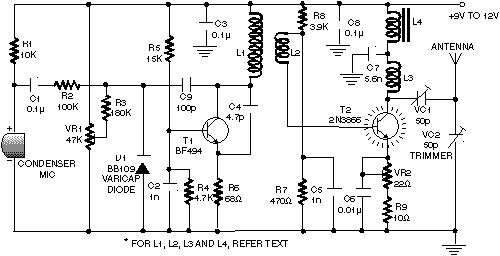
A highly effective 1-watt FM transmitter circuit that is easy to construct. The circuit consists of four transistors: one functions as a stable oscillator, followed by a buffer stage to maintain frequency stability during adjustments. Next is a resonance stage, with the final stage built using a minimum 1W transistor that requires a heatsink. An LM7805 voltage regulator is necessary for the oscillator diodes, while an LM7809 is used to power the T1 oscillator stage, ensuring a stable transmitter frequency. Begin by constructing the oscillator and buffer stages, powering them up and adjusting the 10k linear potentiometer until a blank signal is heard on the receiver. By connecting a small piece of wire to the T2 emitter, it can be observed that the coverage range of the two-stage transmitter is approximately 3 meters. Once the oscillator and buffer stages are confirmed to be functioning properly, disconnect the power supply and proceed to build the T3 resonance stage. After connecting the power supply, adjusting the trimmer (variable capacitor) from the T3 collector will allow variation of the FM transmitter power. This stage is crucial for the proper operation of the entire 1-watt FM transmitter, and the trimmer must be adjusted for maximum power output. The final stage of the transmitter utilizes a 2N4427 transistor (recommended) or other listed transistors. If these are unavailable, a BD139 transistor can be used, but only for frequencies below 90 MHz, resulting in lower output power. Using a 2N2219 transistor for the final stage will yield an output RF power of 0.4W. The last two trimmers should be adjusted for maximum output power at the antenna. Initially, two 100-ohm 0.5W resistors in parallel should be used at the RF output, followed by connecting an RF probe to the output and adjusting all three trimmers, starting from T3 to the output, for maximum multimeter indication. After powering off, connect the antenna and make final adjustments for optimal broadcasting distance. A 12V DC power supply is required for this FM broadcast circuit, with T4 consuming approximately 150 mA at full power output adjustments. The total current consumption for the entire 1-watt transmitter is around 500 mA.
The 1-watt FM transmitter circuit operates by utilizing a series of transistors to amplify and stabilize the radio frequency (RF) signal. The first transistor serves as the oscillator, generating the RF signal at the desired frequency. This is critical as the frequency stability directly impacts the clarity and range of the transmitted signal. The buffer stage, which follows the oscillator, is essential for isolating the oscillator from the load, thereby preventing any frequency drift that may occur during adjustments.
The resonance stage (T3) is designed to enhance the output power and efficiency of the transmitter. It utilizes a variable capacitor to fine-tune the frequency response, ensuring that the transmitter operates at optimal performance. The final amplification stage, which is the heart of the transmitter, is where the output power is significantly increased to the desired level, with a focus on maintaining linearity and minimizing distortion.
The choice of transistors is crucial; the 2N4427 is favored for its efficiency and performance in the RF range, while alternatives like the BD139 or 2N2219 can be used with certain limitations. It is important to ensure that the selected transistor can handle the operating frequency and power levels without overheating, necessitating the use of heatsinks where required.
Adjustment of the trimmers throughout the circuit is a vital step in achieving maximum output power and ensuring proper function. The use of resistors at the RF output during testing helps in safely measuring and adjusting the output power before finalizing the antenna connection.
Finally, the power supply specifications, including the 12V DC requirement and the current consumption, provide essential information for the design and implementation of the circuit, ensuring that it operates reliably and efficiently within its intended application. Proper thermal management and component selection will enhance the longevity and performance of the transmitter, making it suitable for various broadcasting needs.A very good 1 watt fm transmitter circuit, very easy to build circuit. It has 4 transistors, one is a very stable oscillator, followed by a buffer stage to prevent frequency variation when you adjust the transmitter. Next is a resonance stage and the final stage built with a minimum 1W transistor which must have a heatsink.
You must use a LM7805 s tabilizer for the oscillator diodes and one LM7809 for powering up the T1 oscillator stage. This will give you a very stable transmitter frequency. First build the oscillator stage and the buffer, power it up and trim the 10k linear potentiometer untill you can here a blank signal on your receiver. If you put a small piece of wire on the T2 emitter you can see that the cover range of the 2 stage transmitter is about 3 meter.
After you are sure that your oscillator+buffer stage are working properly, remove the power supply and continue building the T3 resonance stage. Connect the power supply and if you adjust the trimmer (variable capacitor) from T3 collector you can see how the fm transmitter power can be varied.
This stage is very important for proper functionality of the entire 1 watt fm transmitter. You must adjust the trimmer for maximum power. The final stage of the 1W fm transmitter is built with 2N4427 (recommended) or the transistors from the list. If you can`t find any, use a BD139 transistor but only for frequencies lower than 90 MHz. The output power will be lower but you get the idea. If you decide to use 2N2219 transistor for the final stage of the transmitter you must know that the output rf power will be 0.
4W. Adjust the last 2 trimmers for maximum output power in the antenna. Initially use 2 x 100 © 0. 5W resistors in parallel at the RF output. Then connect this rf probe to the output and adjust all the 3 trimmers starting from T3 to output. You must adjust it to obtain the maximum multimeter indication. Then power it off, connect the antenna and make the final adjustments for maximum broadcasting coverage distance. Use a 12Vdc power supply to power up this fm broadcast circuit. T4 will have a current consumption of around 150 mA at full power output adjustments. The total current consumption of the entire 1 watt transmitter will be around 500 mA. 🔗 External reference
The 1-watt FM transmitter circuit operates by utilizing a series of transistors to amplify and stabilize the radio frequency (RF) signal. The first transistor serves as the oscillator, generating the RF signal at the desired frequency. This is critical as the frequency stability directly impacts the clarity and range of the transmitted signal. The buffer stage, which follows the oscillator, is essential for isolating the oscillator from the load, thereby preventing any frequency drift that may occur during adjustments.
The resonance stage (T3) is designed to enhance the output power and efficiency of the transmitter. It utilizes a variable capacitor to fine-tune the frequency response, ensuring that the transmitter operates at optimal performance. The final amplification stage, which is the heart of the transmitter, is where the output power is significantly increased to the desired level, with a focus on maintaining linearity and minimizing distortion.
The choice of transistors is crucial; the 2N4427 is favored for its efficiency and performance in the RF range, while alternatives like the BD139 or 2N2219 can be used with certain limitations. It is important to ensure that the selected transistor can handle the operating frequency and power levels without overheating, necessitating the use of heatsinks where required.
Adjustment of the trimmers throughout the circuit is a vital step in achieving maximum output power and ensuring proper function. The use of resistors at the RF output during testing helps in safely measuring and adjusting the output power before finalizing the antenna connection.
Finally, the power supply specifications, including the 12V DC requirement and the current consumption, provide essential information for the design and implementation of the circuit, ensuring that it operates reliably and efficiently within its intended application. Proper thermal management and component selection will enhance the longevity and performance of the transmitter, making it suitable for various broadcasting needs.A very good 1 watt fm transmitter circuit, very easy to build circuit. It has 4 transistors, one is a very stable oscillator, followed by a buffer stage to prevent frequency variation when you adjust the transmitter. Next is a resonance stage and the final stage built with a minimum 1W transistor which must have a heatsink.
You must use a LM7805 s tabilizer for the oscillator diodes and one LM7809 for powering up the T1 oscillator stage. This will give you a very stable transmitter frequency. First build the oscillator stage and the buffer, power it up and trim the 10k linear potentiometer untill you can here a blank signal on your receiver. If you put a small piece of wire on the T2 emitter you can see that the cover range of the 2 stage transmitter is about 3 meter.
After you are sure that your oscillator+buffer stage are working properly, remove the power supply and continue building the T3 resonance stage. Connect the power supply and if you adjust the trimmer (variable capacitor) from T3 collector you can see how the fm transmitter power can be varied.
This stage is very important for proper functionality of the entire 1 watt fm transmitter. You must adjust the trimmer for maximum power. The final stage of the 1W fm transmitter is built with 2N4427 (recommended) or the transistors from the list. If you can`t find any, use a BD139 transistor but only for frequencies lower than 90 MHz. The output power will be lower but you get the idea. If you decide to use 2N2219 transistor for the final stage of the transmitter you must know that the output rf power will be 0.
4W. Adjust the last 2 trimmers for maximum output power in the antenna. Initially use 2 x 100 © 0. 5W resistors in parallel at the RF output. Then connect this rf probe to the output and adjust all the 3 trimmers starting from T3 to output. You must adjust it to obtain the maximum multimeter indication. Then power it off, connect the antenna and make the final adjustments for maximum broadcasting coverage distance. Use a 12Vdc power supply to power up this fm broadcast circuit. T4 will have a current consumption of around 150 mA at full power output adjustments. The total current consumption of the entire 1 watt transmitter will be around 500 mA. 🔗 External reference
